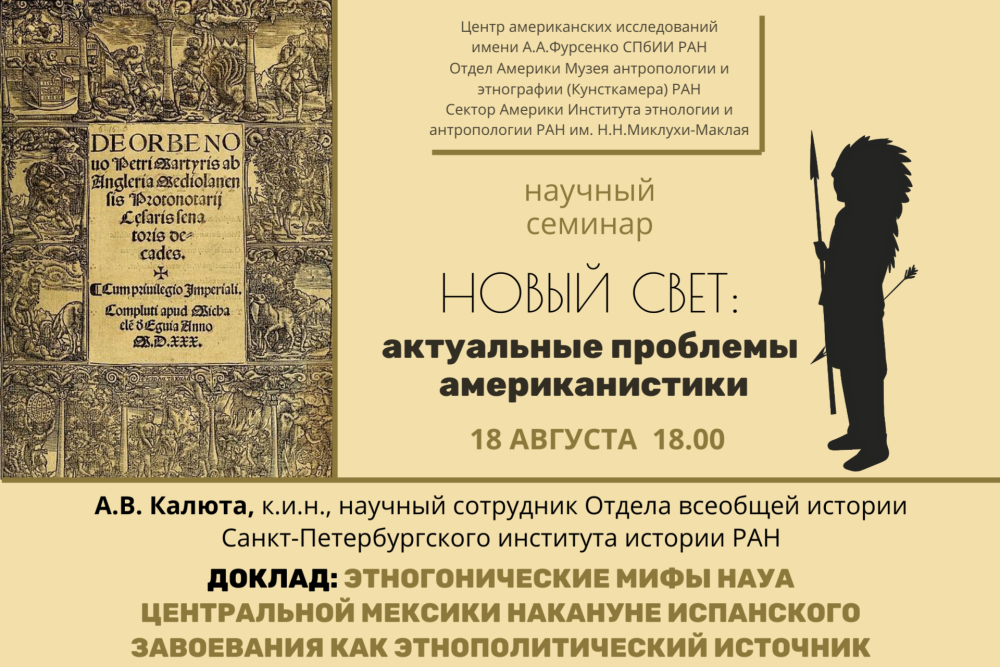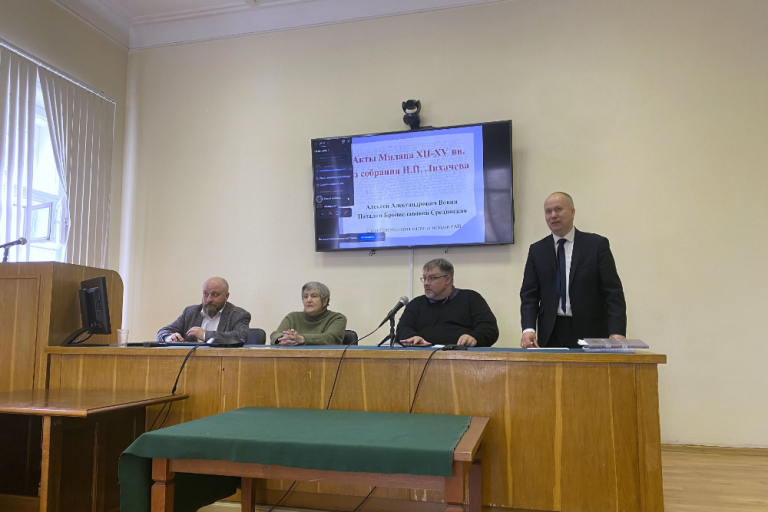
Глубокоуважаемые коллеги!
18 августа 2025 г. в 18.00 в читальном зале библиотеки Музея антропологии и этнографии им. Петра Великого (Кунсткамера) (Университетская наб., д. 3) состоится заседание Американского семинара МАЭ, ИЭА, СПбИИ РАН и РГГУ. С докладом на тему «Этногонические мифы науа Центральной Мексики накануне испанского завоевания как этнополитический источник» выступит Анастасия Валерьевна Калюта, к.и.н., научный сотрудник Отдела всеобщей истории Санкт-Петербургского института истории РАН.
Науа являются одной из крупнейших аборигенных этнолингвистических общностей историко-культурной области Мезоамерика, представляющей собой изолированный от Старого Света очаг происхождения и развития ранних государств. В настоящее время они населяют, главным образом, горные области Центрального плоскогорья и юга Западной и Восточной Сьерры-Мадре в Мексике. Отдельные, ныне весьма немногочисленные группы науа живут в странах Центральной Америки: Сальвадоре, Никарагуа и Коста-Рике. В настоящем докладе рассматриваются этногонические мифы и предания науа Центральной Мексики, прежде всего долины Мехико накануне испанского завоевания. Это астеки или мешика и аколуа создателей конфедерации Тройственный Союз, часто и ошибочно именуемой «астекской империей», а также значительно менее изученные мифы чальков, жителей юго-восточной части долины Мехико, и тлашкальтеков, обитателей современного штата Тласкала в восточной части Центрального плоскогорья. Такой подход к материалу позволяет осуществить сравнительный анализ нарративов этнически близких, но при этом разных по своему самосознанию и культурным традициям групп, и выделить в них основные элементы, касающиеся миграций науа в Центральную Мексику, их отношений с автохтонным населением и основания их собственных государств и правящих династий. Целью данной статьи является анализ этногонических мифов астеков, аколуа, чальков и тлашкальтеков как этнополитического источника, позволяющего реконструировать ранние этапы их истории, основные общественно-политические институты, а также их этническое самосознание и представления о власти и формах ее легитимации до испанского завоевания.
Abstract
The Nahua is one of largest indigenous ethnolinguistic entities of the cultural area of Mesoamerica, a center of origin and evolution of early states which is isolated from the Old World. Today they live predominantly in mountain areas of the Central Plateau and southern region of the Sierra Madre Occidental and the Sierra Madre Oriental in Mexico. Few Nahua groups currently inhabit the Central American countries of Salvador, Nicaragua and Costa Rica.This paper examines the origin myths of three large Nahua ethnic groups of Central Mexico before the Spanish Conquest. These groups are the Aztecs or Mexica and Acolhua, the founders of the Triple Alliance confederation, frequently and erroneously called the «Aztec empire»; the Chalca, the inhabitants of the south-eastern part of the Basin of Mexico, and the Tlaxcaltecas, the residents of the present-day State of Tlaxcala in the eastern part of the Central Plateau. This approach permits conducting a comparative analysis of the narratives of ethnic groups that have common origin but different identity and cultural traditions, as well as to detect basic elements concerning Nahua migrations to Central Mexico, their relations with the autochthonous population and the foundation of their proper states and dynasties in the Late Postclassic Period, that is in the 13–16th centuries. The aim of this article is the analysis of the ethnogenesis myths of the Aztecs, the Acolhua, the Chalca and the Tlaxcaltecas as an ethnopolitical source, which allows to reconstruct the early stage of their history, the main sociopolitical institutions, their ethnic identity and notions about power and forms of its legitimization before the Spanish Conquest.
Resumen
Los nahuas son una de las unidades etnolingüísticas más grandes del área cultural de Mesoamérica, un centro de origen y desarrollo de los estados tempranos aislado del Mundo Viejo. Actualmente la mayoría de ellos viven en las áreas montañosos del Altiplano Central y del sur de la Sierra Madre Oriental y la Sierra Madre Occidental en México. Unos grupos nahuas de número escaso en presente habitan en los países de América Central: Salvador, Nicaragua y Costa Rica. La ponencia se enfoca en los mitos de origen de tres grandes grupos étnicos del Altiplano Central en vísperas de la Conquista. Estos grupos son los aztecas o mexica, los acolhua — creadores de la confederación de la Triple Alianza, frecuentemente mal llamada «el imperio azteca», los chalca, habitantes del sureste de la Cuenca de México, y los tlaxcalteca, vecinos del actual estado Tlaxcala en el este del Altiplano Central. Tal enfoque permite realizar el análisis comparativo de las narraciones míticas de tres grupos étnicos de origen común, pero de identidad y tradiciones culturales distintas y elucidar los elementos básicos vinculados con migra- ciones nahuas en el México Central, sus relaciones con la población autóctona y fundación de sus propios estados y dinastías en el Período Posclásico Tardío (es decir de los siglos XIII–XVI). El objetivo del artículo es examinar los mitos de origen de los aztecas, acolhua, chalcas y tlaxcaltecas como fuentes etnopolíticas, lo que permite reconstruir las etapas tempranas de su historia, sus principales instituciones sociopolíticas, sus nociones de poder y formas de su legitimación antes de la Conquista.



